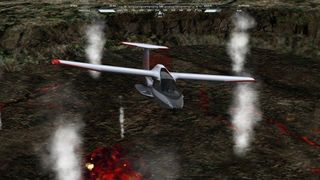Microsoft Flight preview

Taking wing on your PC has traditionally been the bailiwick of Microsoft and its many Flight Simulator variants over the years (as well as an enthusiastic modding community). From Bruce Artwick's formative early 1980's releases to 2006's series-concluding Flight Simulator X, the best way of getting a heavier-than-air craft aloft via Windows has been through flight entertainment products published by the OS's manufacturer. That tradition continues—after a six-year hiatus—with the release of Microsoft Flight.
This is definitely a bird of a different feather, however, because unlike the title's many predecessors, Microsoft is releasing Flight as a free-to-play product through its Games for Windows Live service. The initial download includes two planes—a classic Boeing Stearman biplane and the still-in-development Icon A5 amphibious concept aircraft—as well as an intricately modeled version of the big island of Hawaii to hop around in.

Free stuff is great but, for the record, the gravy train ends with this two-plane, one-island Starter Pack. If you want to expand beyond the beaches of the big island you'll need to buck up $19.99 for the Hawaiian Adventure Pack, which adds the full eight-island Hawaiian chain and a Vans RV-6A two-seater kit plane. Expanding your hangar will also cost. Downloadable content aircraft will initially include the Maule M-7-260C and North American P-51 Mustang at $14.99 each (or $7.99 for an exterior view only “basic” model).
That last option is a dead giveaway. Flying an airplane from an outside view effectively removes you from the simulation experience and plunks you straight into gaming territory, a direction Microsoft is unapologetically heading with Flight. The game does offer some appeal to hardcore simmers—the superb terrain graphics feature some of the best optimization techniques to ever grace a flight sim—but it's clear MS is rebooting this lucrative franchise for a new demographic… the casual gamer.

“Microsoft Flight is not the next logical extension of the Flight Simulator franchise and its enhancements will make the experience of flight more enjoyable to a wider range of users as well as the long time FlightSim enthusiast,” explains Executive Producer Joshua Howard. “[It] will have new structured gameplay that will take on a more persistent nature to give users that great sense of accomplishment and to keep them coming back for more.”
Translation: MS hopes to tap into an entirely new audience of virtual pilots with Flight, one that doesn't own a joystick (or rudder pedals or independent throttles) and is largely disinterested in by-the-book FAA flight procedures. To that end, the game's development team—about a third of whom were part of the original Ace's Studio that produced FSX—has created one of the better keyboard and mouse control schemes I've ever used, binding aileron, elevator, and rudder responses to appropriate fore, aft, and lateral mouse movements and a convenient mouse wheel throttle. Hardcore sim fans will eschew the gimmick (most have a significant peripheral budget to defend) but, for newbies, this is a significant development that lets them execute three-point landings and basic aerial maneuvers with relative ease.

“Mouseable” planes may help expand the franchise's user base but the game's aircraft respond better to a proper flightstick. The Icon and Stearman are simple planes—neither features complex radio equipment for Instrument Flight Rules navigation—but the game's physics are still realistic enough that nailing a crosswind landing in either machine cries out for independent rudder action. “At a simulation level, Flight features a more sophisticated flight model than the franchise has ever seen,” states Howard. “Real world pilots tell us that Microsoft Flight has captured the airplanes available so far better than they have ever experienced. We did this by continuing to invest in a deep simulation, but then softened it in ways to ease a brand new user into the experience.”
PC Gamer Newsletter
Sign up to get the best content of the week, and great gaming deals, as picked by the editors.
Better yet, the picturesque and impressively detailed Hawaiian scenery doesn't demand a ton of PC horsepower and I was able to max out all of the beta's graphic options on my aging dual-core system without any slowdowns or hiccups. This is a game built for aerial sightseeing and, from the historic Waipio Valley cliffs to the crevices of the Hawaii Volcanoes National Park, Microsoft has produced some truly memorable sights. To keep the gaming crowd occupied, they've also thrown in a number of treasure hunt-style aerocache challenges and missions and, for those who like company when they fly, a 16-person Games For Windows Live multiplayer component.

Commercial and community-built scenery, aircraft, and add-ons helped push Flight Simulator X (and previous FS chapters) to extraordinary heights but Microsoft Flight will remain a closed shop for the foreseeable future. For a free-to-play game it's an impressive and approachable piece of work that's well worth the download for both casual gamers and hardcore simmers. As for whether its in-house, pay-as-you-go aircraft and scenery can keep it in the air, only time will tell.
Most Popular

